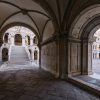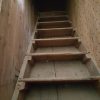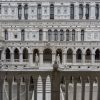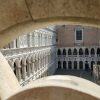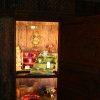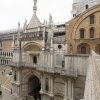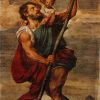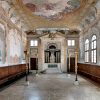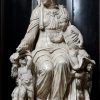New guided tour in the Doge’s Palace
Following the extensive conservative restoration work that has restored the original splendour of its interior, the evocative rooms of the Chiesetta and Antichiesetta del Doge are the fulcrum of a new, fascinating artistic-historical tour to discover The Doge’s Hidden Treasures in the Doge’s Palace.
The new itinerary, which requires reservations and a qualified guide (see general information), is an addition to what is already an extraordinary cultural offer from Fondazione Musei Civici in Venice; it unfolds in the Doge’s private rooms in the wing of the Doge’s Palace adjacent to the Basilica.
This fascinating itinerary explores locations originally inaccessible to the public. The guided tour begins at Porta della Carta, the monumental 15th-century entranceway leading to the Terrazza Foscara, where visitors are met by nostalgic 19th-century sculptures that recall the ancient, mythical glories of Venice.
The tour continues to the Loggia Foscara, a Renaissance addition to the Gothic layout of the Palazzo Ducale. Inside, after passing through an antechamber set up as a defence area, visitors enter the heavily armoured Sala dei Forzieri, the ancient Treasure Chamber, where a selection of precious artefacts from the depositories of Venice’s civic museums have been returned to public display.
The tour then leads to the Doge’s Terrace, a panoramic vantage point for viewing the east, west and south wings of the Doge’s Palace. From there, the route passes briefly through the Doge’s Apartment, a series of rooms specially reserved for him.
At this point visitors climb a steep staircase, where behind, like a backdrop, hangs Titian’s monumental fresco from 1523, depicting a robust St. Christopher carrying the Child Jesus across the lagoon waters.
At the top, the tour arrives at the evocative Chiesetta del Doge (Doge’s Church), redesigned by the architect Vincenzo Scamozzi. The chiesetta houses a sumptuous altar with the 16th-century sculptural group Madonna con il Bambino e quattro angeli by Jacopo Sansovino and workshop, as well as allegorical frescoes from the mid-18th century by Jacopo Guarana and illusionistic painters Girolamo and Agostino Mengozzi Colonna, which enlarge the spaces with limpid colours and trompe-l’oeil effects.
Finally, one enters the Doge’s Antichiesetta, also frescoed by Guarana, where three canvases depict the Traslazione del corpo di San Marco, painted in 1727 by Sebastiano Ricci as models for the mosaics for the second external portal of St. Mark’s Basilica.
Discover admission conditions to THE DOGE’S HIDDEN TREASURES tour >
